A Den of Thieves
We usually do not write about the charges against Richard Ramirez in San Francisco (SF) because the SF legal documents are unavailable. Most of what we know about the San Francisco charges against Richard comes from news articles available at the time, as well as small pieces of information contained within the 2008 Federal Petition for Writ of Habeas Corpus. Because we seek to be authentic and write about things that can be verified with reliable sources, and most of what is written about Richard outside of legal documents is based on speculation, outright lies, or the result of a “he said-she said” scenario, we are limited in writing about the San Francisco case. However, as there are many questions surrounding the SF case against Richard, we want to discuss the limited information that is available and where it came from.
The purpose of this post is to provide the reader with some of the information presented by the media regarding the San Fransico case against Richard. While the news articles give us some helpful information, we must take the newspaper writings with a “grain of salt” as law enforcement and the media were highly biased towards Richard and continue to be so to this day. This post is an introduction to the people Richard spent time with in San Franciso. The SF crimes will be discussed in a future post.

Richard Ramirez had several relationships that had a significant influence on his life. Exploring some of these relationships is essential to understanding the events leading up to his arrest in August 1985.
Richard grew up in El Paso, Texas, and per his mother’s statement to federal public defenders in 2008, he moved to California in 1979. He spent time in Los Angeles and San Francisco, vacillating between the two cities from 1979 to 1985. Richard’s key relationships in California were with Reyes Garcia, also known as “Arabe” or “Ray,” Antonio Reyes, Armando Rodriguez, Donna Myers, and Earl Gregg. Reyes Garcia (Arabe), Armando Rodriguez, and Antonio Reyes were all childhood friends of Richard’s from El Paso who moved to California in 1979-the early 1980s.
Cynthia Melendez, Reyes Garcia’s one-time girlfriend, was also a childhood friend of Richard’s. She gave a sworn statement to federal public defenders in 2008 describing her interactions with Richard and Reyes (Arabe) in 1979 and early 1980s. In 1978, Cynthia and Arabe had a daughter they named Gretchen. Cynthia stated they moved into a house together in early 1979 in “La Roca,” in El Paso. They both smoked and sold marijuana, not only in Texas but in other states such as California and Oklahoma. They also had LSD parties. Richard smoked marijuana and took LSD with them. Arabe and Cynthia had a separate building on their property that they cleaned up for Richard to move into in March 1979. Cynthia stated she never hesitated to leave her daughter with Richard, and sometimes he babysat for her.

*from 2008 Federal Petition for Writ of Habeas Corpus supporting document 20-8
In June or July of 1979, Cynthia and Arabe moved in with her mother, and around this time, Richard moved to California. In the early 1980’s, she and Arabe went to San Franciso to meet up with Richard. Cynthia, Arabe, Richard, and another friend from El Paso, Armando Rodriguez, rented a house together in San Francisco for a brief time. Cynthia described an occasion when she, Arabe, and Richard drove from San Francisco to a nice neighborhood in Orange County, California. Richard and Arabe got out of the car and told her to wait in the vehicle. A while later, Richard and Arabe returned to the car and drove back to San Francisco. Shortly after returning to San Francisco, Cynthia saw Richard and Arabe with jewelry and guns stolen from the home in Orange County.

*from 2008 Federal Petition for Writ of Habeas Corpus supporting document 20-8
Shortly after Richard’s arrest, Arabe spoke to reporters from the San Francisco Examiner on September 1, 1985. His remarks were contradictory to the sworn statement given by Cynthia Melendez to Richard’s attorneys in 2008. Arabe told reporters that he only saw Richard at game arcades and 7-Eleven convenience stores while living in El Paso. He failed to mention he and Richard were schoolmates, had burglarized and partied together, and that Richard had lived on his property for several months in 1979. Perhaps Arabe suffered from selective amnesia and conveniently forgot to mention his long-time connection to Richard.

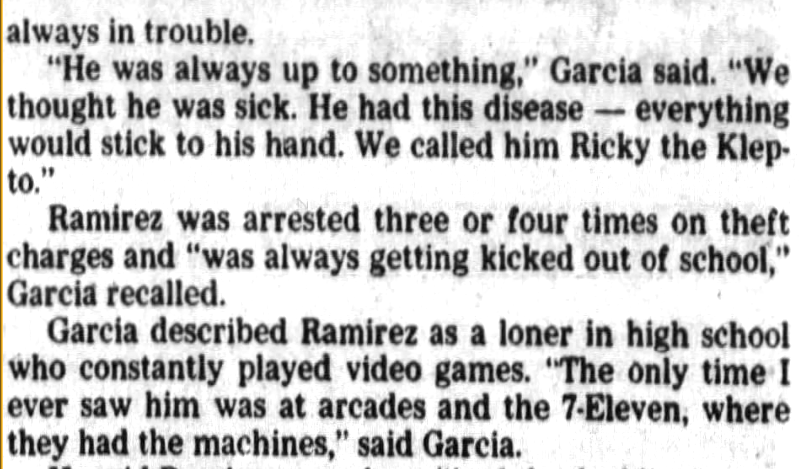
San Francisco Examiner, September 1, 1985, p.20
Antonio Reyes was also a childhood friend of Richard’s who gave a statement to federal public defenders in 2008. Antonio stated sometime during 1979-1980, he moved to Richmond, California, along with another childhood friend, Armando Rodriguez. Shortly afterward, Armando met and moved in with a woman named Donna Myers. Richard often visited Armando at Donna’s home. Antonio described an incident in 1984 or 1985 where he and Armando found Richard in a motel on Mission Street in San Francisco. He stated all the lights were off in the room, and Richard was “out of it” and looked sick, pale, confused, and depressed. Richard told him he was not feeling well. Antonio thought Richard appeared to have just recently had a seizure.
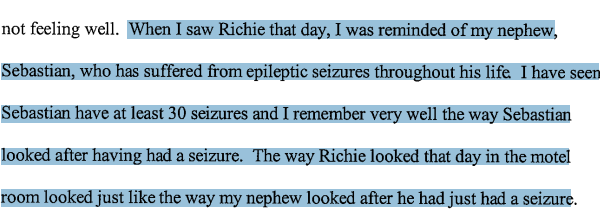
*from 2008 Federal Petition for Writ of Habeas Corpus supporting document 20-8
Donna Myers was an acquaintance of Richard’s who lived in San Pablo, California. Per the San Francisco Examiner, on September 4, 1985, Donna said she met Richard through Armando Rodriguez. In 1979, she and Armando made a trip to Armando’s hometown of El Paso, and it was at that time she met then-19-year-old Richard. Between 1979 and 1981, he stayed at her home in Richmond, California, a few times. She later moved to San Pablo, where Armando and Richard visited her frequently. Donna said Richard, whom she knew as Rick, was never violent, and she never saw him with any weapons. She described him as being “very nice and very polite.”
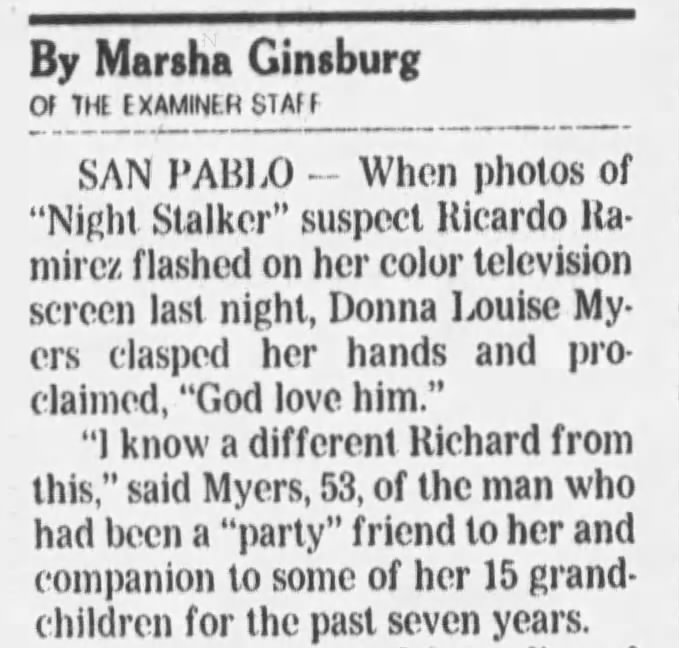
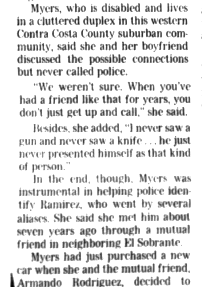
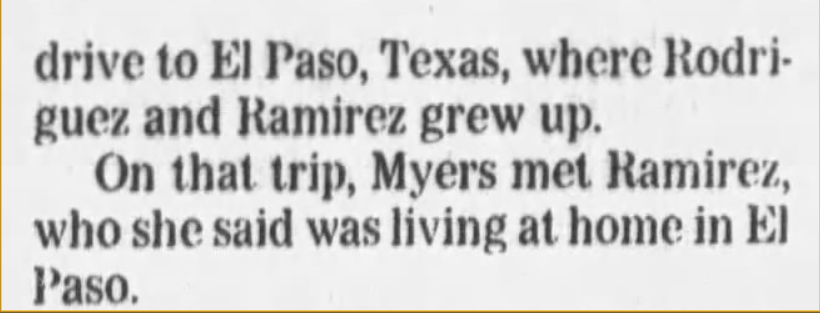
*San Francisco Examiner, September 4, 1985, p.10
Earl Gregg, another San Francisco acquaintance of Richard’s, was Donna Myers’s son-in-law. He was married to Donna’s daughter, Deleen. Earl reportedly also met Rick (Richard) through Armando Rodriguez. In the Lompoc Record from September 5, 1985, Earl claimed he lived with Richard in Richmond, California, in 1981 for four months. The suspicion about Richard being the Night Stalker was triggered by Gregg’s sister, Laurie Ochoa, who convinced Earl that their friend looked like the Khovananth police composite. Gregg did not initially agree. Although the teeth sounded similar, the composite did not resemble Richard – the chin was too long, the hair too curly, and the eyes large and bulging. Even though he believed the police composite of the Night Stalker suspect did not look like Rick, Earl stated, “There were just too many coincidences.” Seeds of doubt had been planted.
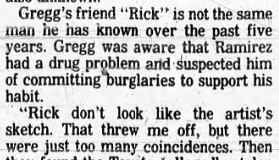
*Lompoc Record, September 5, 1985, p.1
Armando Rodriguez and Richard Ramirez grew up together in El Paso. They were childhood friends and lived together briefly in California, hanging out and partying with a mutual friend, Donna Myers. Armando is the one who gave police Richard’s legal name, allowing police to put a name and face to the Night Stalker. It seems Armando did not readily sell his long-time friend down the river but only did so after succumbing to police brutality at the hands of San Francisco Police Detective (SFPD) Frank Falzon, an incident in which the retired investigator brags about in the Netflix documentary, Night Stalker: The Hunt for a Serial killer. “Not my best punch, but definitely not my worst,” he recalled.

San Francisco Examiner, September 1, 1985, p.20
Why do these relationships matter and why should we care?
It’s fair to say Richard did not surround himself with the most upstanding individuals. Every person that betrayed him had something to gain. For decades, all we have learned of Richard has come from biased sources, such as law enforcement, the media, and those seeking fame and fortune from his sad, unfortunate story. Excluding the 2008 Federal Petition for Writ of Habeas Corpus, this is the first time his history has been described based on what can and cannot be found in legal records and his relationships in San Fransico have been explored.
All of the individuals discussed above interacted with Richard regularly. They knew about his lifestyle and were either involved in the same activities as Richard, specifically burglarizing and drug use or were a willing recipient of stolen goods. Three individuals mentioned, Armando, Donna, and Earl were instrumental in Richard being identified and arrested as the Night Stalker. But why did they turn on Richard? What motive did they have for doing so? By the time Richard was arrested, the monetary reward for the capture of the Night Stalker was over $70,000. Perhaps they were merely trying to cover their ass or collect the reward money.
Et tu Brute?
On August 26, 1985, Earl Gregg, at the insistence of his sister, Laurie, called the San Francisco Police Department (SFPD) and told them he thought his acquaintance, Rick, might be the so-called Night Stalker. The call was made on August 26, four days after San Francisco police announced the Night Stalker had arrived in their city. Even though the Greggs admitted the idea that their friend could be the Night Stalker was preposterous, they reported him anyway. After all, a large reward was being offered by both Los Angeles and San Francisco, and the Greggs were struggling financially. Earl did not have a last name for Rick, so he led the police to his mother-in-law, Donna Myers, who also knew Rick. Although Richard had visited Donna’s home numerous times, she only knew him as “Rick Mena.” However, she knew someone who did know “Rick’s” last name: Armando Rodriguez.
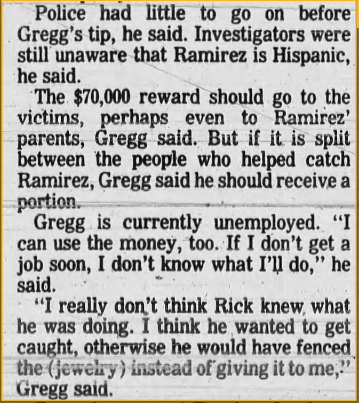
Lompoc Record, Sept. 5, 1985, p.5
Shortly after Donna disclosed this information to police, the nearly two days of “questioning” of Armando Rodriguez by SFPD and Detective Falzon began. After Rodriguez was taken in for questioning and told he would be charged with accessory to murder unless he gave up information, he admitted to seeing Ramirez on August 16 and receiving stolen goods. Deleen’s mother, Donna, with whom Richard was staying, alleged that she had received stolen jewelry from Richard on August 16, as well. She had given two of the stolen items to her daughter, Deleen. Earl Gregg also claimed he received stolen property from Richard approximately two weeks before Richard’s arrest.

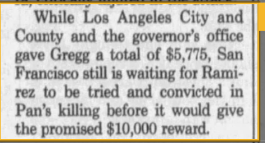
The San Francisco Examiner, Feb 20, 1995, P. 5
Are we to believe that of those that Richard hung out with, he was the only one with a drug problem or who committed burglaries? I have a hard time believing these acquaintances did not commit burglaries and engage in drug use, just as Richard did. We know, per Cynthia’s Melendez’ sworn statement, that Arabe, in fact, did commit burglary and use drugs with Richard. If these SF associates weren’t involved in similar activities, why did they willingly accept stolen goods and pass them on to family members? Why did they willingly have Richard in their home?

There are at least three potential reasons why Richard’s so-called friends may have turned on him: Immunity from prosecution for possessing stolen property, accessory to murder, and reward money.

KayCee & VenningB

Leave a comment